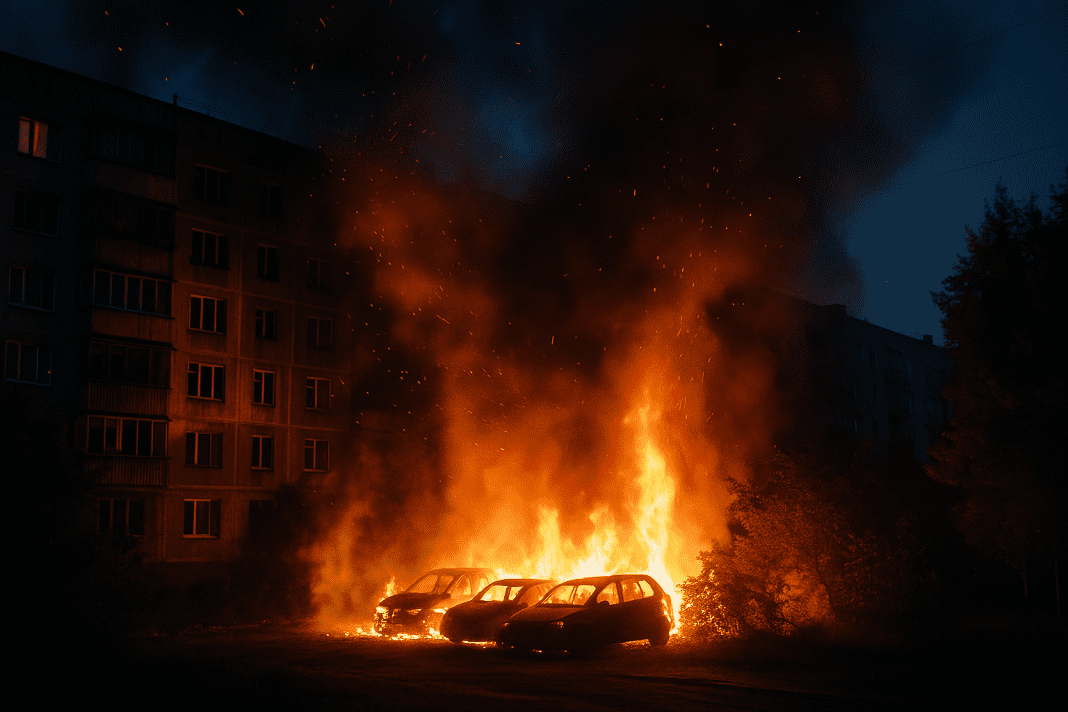In the early hours of July 20, a major fire broke out in Zelenograd, a city just 37 kilometers northwest of central Moscow. The cause? What Russian officials claim to be a massive wave of Ukrainian drones—93 in total—launched toward multiple Russian regions, with 21 targeting Moscow Oblast alone. The most intense activity occurred in Zelenograd, where drone debris reportedly struck residential buildings, igniting vehicles and causing panic among local residents.
Russian emergency crews rushed to the scene shortly after reports emerged on local Telegram channels. Videos circulating on social media showed cars engulfed in flames, and what appeared to be damaged high-rise apartments. While no official casualties were immediately reported, the scale of the attack and the fire’s proximity to residential areas have raised serious concerns.
Security camera footage shared by the Russian Telegram channel Baza appears to show fragments of a drone crashing into the upper floors of a residential building. Local residents claim they heard loud explosions, followed by plumes of smoke and emergency sirens throughout the night.
This marks the fourth consecutive night of drone strikes targeting Moscow and its surrounding regions, signaling a sharp escalation in the drone warfare tactics that have become central to the ongoing conflict between Russia and Ukraine.
Airports Disrupted, Capital on Alert
Flight restrictions were lifted around 4 a.m. local time, but the disruption was significant. The temporary no-fly zone not only grounded several inbound and outbound flights but also served as a stark reminder that the Russian capital is no longer insulated from the frontline of the war.
The Defence Ministry of Russia later claimed that all 93 drones had been intercepted, with 19 being shot down over Moscow Oblast. Despite these claims, visual evidence and local reports suggest that at least some drones or debris made contact with urban structures, sparking fires and fear among residents.
Meanwhile, Russian media outlets attempted to downplay the incident, focusing on statements from Moscow Mayor Sergey Sobyanin, who confirmed the attacks but withheld information regarding damage or injuries. Sobyanin said emergency crews were on the ground and responding, but did not offer further details.
Drone War Intensifies
The use of drones has become an increasingly dominant feature of the Russia-Ukraine war. In recent months, Russia has launched repeated drone assaults on Ukrainian cities, including Kyiv, causing widespread damage to infrastructure and civilian areas. Now, it appears Ukraine is intensifying its own drone campaign, with the Russian capital emerging as a prime target.
Although Ukraine’s government typically does not comment on attacks inside Russian territory, these strikes align with recent Ukrainian efforts to target military, industrial, and strategic assets within Russia’s borders. The goal: to undermine Russia’s logistical and technological infrastructure, and to bring the war closer to the Kremlin.
The timing of the attacks also coincides with rising international tensions. Just days before the July 20 attack, reports emerged that former U.S. President Donald Trump had warned the Kremlin that it had 50 days to negotiate peace or face severe tariffs if he returns to power. According to the Financial Times, Trump allegedly asked Ukrainian President Volodymyr Zelensky whether Ukraine could strike Moscow if the U.S. supplied long-range weapons. Zelensky reportedly said such an attack would be possible with American support.
🔐 Ukraine wipes Gazprom’s core systems in massive cyber blitz—servers destroyed, 390 branches hit
However, Trump later distanced himself from the idea, telling the press that he would not support Ukrainian strikes on Moscow, nor would he supply long-range missile systems.
Regardless of foreign politics, Ukraine’s military seems to be moving forward, using drones as a relatively low-cost and flexible way to pierce through Russia’s vast air defenses. By targeting cities like Moscow, even with limited physical damage, Ukraine delivers a psychological and strategic blow, shaking the illusion of Russian homeland security.
The Zelenograd fire, with its dramatic visuals and civilian proximity, serves as a chilling symbol of this evolving battlefield.
A New Phase in the Conflict
The repeated strikes on Moscow over four nights suggest that the war has entered a new and more unpredictable phase. Russia’s capital—long considered untouchable—is now facing nightly threats, grounding planes, triggering emergency responses, and placing ordinary Russians directly in harm’s way.
While official Russian narratives will likely continue to emphasize air defense successes, the reality on the ground shows a shifting balance. The psychological impact of drone attacks in the heart of Russia is profound, signaling that no region is entirely out of reach.
Whether or not Ukraine officially acknowledges its role, the signs are clear: Zelenograd was hit, fires burned, and Moscow is on high alert.
As the war continues, it is likely that these attacks will become more frequent, more targeted, and more disruptive. The skies above Moscow are no longer safe, and the fire in Zelenograd may be just the beginning.

